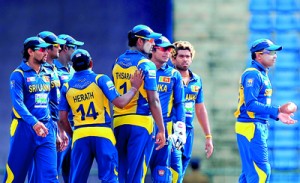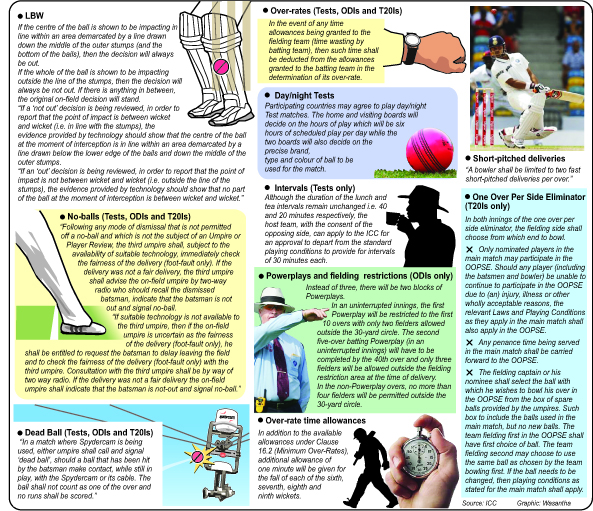Proper use of crease to face the new changes
View(s):I feel one of those things that have not changed in the cricket manual is the forward defence. It is said that once a player knows how to play the proper forward defence at a tender age he could develop the correct technique to play the rest of the shots in the cricket book. Out of the lot, the newly discovered scoop shot may be the only shot that one plays with his eyes off the ball.
Cricket is entrenched with guidelines. In batting one has to get the eyes, wrists, feet and the rest of the body in proper shape to play a proper stroke. In bowling – the arm position, how you place the seam in your fingers according to what you intend bowling and the placement of your feet and eyes are important.

Some captains play on the backfoot where the new playing ODI playing conditions are concerned. But, they may have nothing to fear after all.
Yet the game has evolved through the past three hundred odd years to what it is today. It is still changing by the season. Changes are effected as and when the IC’s Cricket Committee deems that something must be done to make a section of a particular segment of the game more interesting or competitive.
Last year the ICC’s then cricket committee comprising Clive Lloyd (West Indies), Sharad Pawar, Haroon Lorgat, Ian Bishop (West Indies), Mark Taylor (Australia), Kumar Sangakkara (Sri Lanka), Tim May (Australia), Gary Kirsten (South Africa), Clare Connor (England), Justin Vaughan (England), Trent Johnston (Ireland, but born in Australia), Ravi Shastri (India), Steve Davis (Australia), Ranjan Madugalle (Sri Lanka) and David Kendix (England) recommended sweeping changes. They were approved by the Board of Directors of ICC in London in May and were put into practice from the current Sri Lanka v New Zealand series.
The new playing conditions for Tests, One-Day Internationals (ODIs) and Twenty20 (T20s) came into effect with the matches that began in Pallekele on Tuesday October 30.
The ICC also reiterated that it was important to note that the playing conditions were applicable to international cricket and must be read together with the Laws of Cricket. Whilst a playing condition may affect the Laws of Cricket as they may apply to international cricket, these new changes are not amendments to the Laws of Cricket themselves.
However some of the new clauses have raised some eyebrows in the cricketing circles. Their concerns were largely over the ODI segment portion which reads as “Powerplays and fielding restrictions – Instead of three, there will be two blocks of Powerplays.”
In an uninterrupted innings, the first Powerplay will be restricted to the first 10 overs with only two fielders allowed outside the 30-yard circle. The second five-over batting Powerplay (in an uninterrupted innings) will have to be completed by the 40th over and only three fielders will be allowed outside the fielding restriction area at the time of delivery.
In the non-Powerplay overs, no more than four fielders will be permitted outside the 30-yard circle.
The non-Powerplay overs clause seems to have unruffled the feathers of even some learned cricketers, including Sri Lanka captain Mahela Jayawardena. They feel with this new introduction the deployment of spin bowling as an attacking weapon in ODI cricket has been nullified to a great deal.
In the mid-overs as we generally refer to it, the bowling side generally goes down to second gear. In the Asian block it is the spinners who operate in this period. In the bigger built West and the very Far East it is the slow medium and (if so) spinners who take over the middle overs. When this happens the batsmen also change gears after walloping the opposing attack during the Powerplay overs. In short both teams use this period to build strategies.
In the Indian sub-continent the captains tighten the grip on the opponent by slowing down the pace with spin bowlers cutting down the runs with crafty field placings.
Now with only a maximum of four fielders outside the thirty yard ring at any given time, a captain who generally operates with his spinners during the mid-overs may fear that he will not be able to restrict the opposing batting and it may nullify the advantage that he has with spinners. The reason – he may not be able to set his field in a manner that would restrict the batsman’s ability to score freely. They feel that this may lead to the captains in the Indian-subcontinent fearing to use spinners in his ODI line-up.
However there is another school of thought who feels that these changes were made to bring in a new surge to the flagging mid-overs, and captains still can restrict the run flow if the bowlers in his arsenal are crafty enough.
The other side points out, in spite of the argument that a spin-prong attack may be at a disadvantage in this inaugural ‘New Playing Conditions’ series the Sri Lankan skipper Mahela Jayawardena used three spinners in ten out of the thirty three overs permitted in the third one-day international while in the second ODI, the Lankan premier spinner Rangana Herath bowled his ten overs for 28 runs in spite of the opposition scoring 250 runs in their allotted 50 overs.
They also pointed out generally it is the quality of the bowler that matters. A bowler if he is with quality he will know how to restrict the opposition and an ordinary trundler will not know where to pitch his deliveries if he gets lofted for a few good blows.
The same forum also points out that this is one of the main reasons that the Cricket Committee of Sri Lanka cricket would have wanted to restrict the number of first class teams taking part in the Premier League tournament. They would have wanted a lean and mean tournament where the best quality cricket is played and no below par performers are entertained or have the ability to sustain.
Finally it is encouraging that sanity prevailed when the club forum met the SLC authorities and managed to arrive at a futuristic solution.
Now the most interesting item in the agenda would be the MOU that would be signed between the SLC and the club forum. We at this end feel with the new agreement the changes which would have taken two years now will come in three years. But, these changes which are being effected should be put into a time frame.
The new tournament should run at least for ten years so that Lankan cricket could enjoy its benefits as it could produce the new set of World Cup winners and only the MOU could contain the magic spells to that effect.
 |
Follow @timesonlinelk
comments powered by Disqus
























